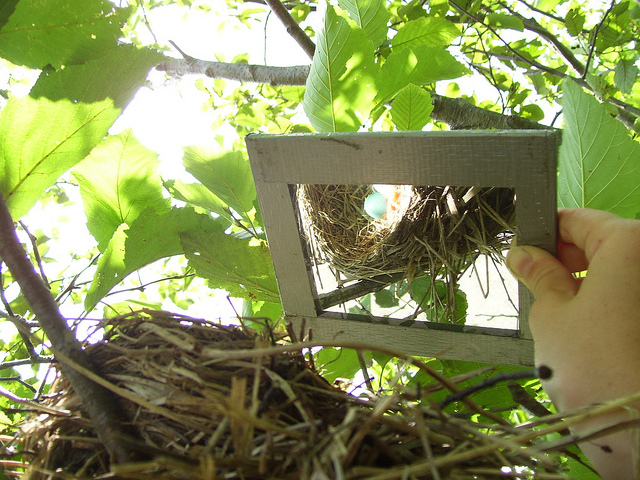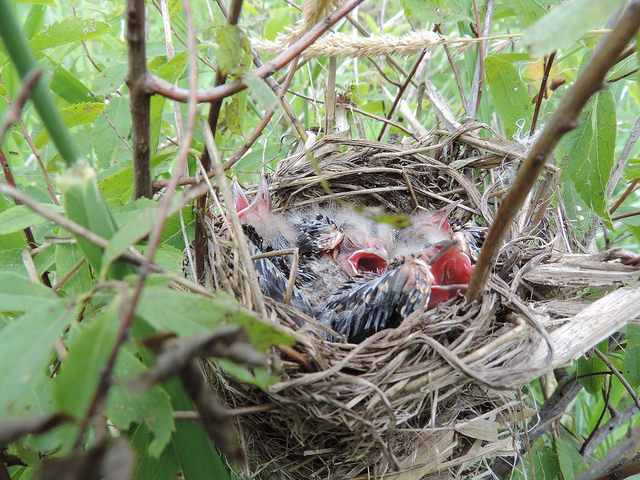There is both skill and art involved in taking natural materials and fashioning them into a useful object. Humans have done this in the past, harvesting plants and turning them in shelters, clothes, furniture and tools. I can’t help but wonder how they figured it out, and if they watched the birds in the spring in the flurry of nest building.
It is inspiring, observing birds gathering materials found in abundance in the natural world and turning them into cradles for eggs and babies. Many times I have tried to mimic their creations by weaving grasses and mud together and never has it been so structurally sound nor as elegant. And I have opposable thumbs. With just a beak? Tough.
Watching nests has been a human pastime for the duration of modern humans, I imagine, though the end goal was likely sustenance rather than the more modern goal of scientific research or curiosity. In 1965 Cornell University’s Lab of Ornithology began the North America Nest Record Card program. The appeal was widespread and within a few years the lab was receiving thousands of records from over 1,000 contributors. Currently the program has 330,000 records of more than 600 species. The 2008 incarnation of the program is NestWatch and you can find details at nestwatch.org.

Using a mirror to check a high nest.
One of the truly fascinating aspects of nest building is how the birds choose the location of their nests. I’m uncertain what implies “safe” to a bird, but the American Robin who built a nest under the fender of the dump truck obviously didn’t understand our spring work schedule. I found the nest after there were eggs, but before she started incubating. Interestingly, during this time the dump truck went up the hill one afternoon, nest and eggs along for the ride, to haul firewood. Upon its return to the parking spot, mom flew in as if nothing was amiss. After that I did move the nest to the only location within ten feet, which was the rear tire of the backhoe. Mom readily accepted the relocation, incubated, hatched and raised four young. It was a minor inconvenience to not use the machine for a few weeks.
As many nests have been built close to my house, I’ve had the opportunity to watch the nest being built, observe and study the eggs and the nestlings. Some are more skittish than others, but most adapt to my presence readily. I do have to modify my behavior at times, walking a different way around the house, avoiding working outside in the garden when it is cold so as not to spook mom off the nest. I don’t mind. The window into these birds’ lives is worth the inconvenience.
After the birds have fledged and the season is over, I remove the nests. This allows the parent birds to build a new one next year in what they determined was a good location. Phoebes nested on the bat house for six years in a row, often hatching two broods a year. This year they have moved to the wood shed, which means I will delay my stockpiling of next winter’s wood but get to see the nest at eye level. A tradeoff I’m happy to make.
The opportunity to study the nests as I remove them, both in the locations the birds choose and in the nest boxes that I have put up, is one of the incentives for providing haven to the birds. I truly believe that there is no greater mastery of animal architecture than birds’ nests. Using grasses, moss, leaves, twigs, mud, feathers, fur, and more the birds are born with the knowledge of how to weave those materials together to create a safe a secure place to raise their family.
Nests come in all shapes and sizes, as varied as the birds that create them. Shallow saucers of fine animal hair to bulky sticks fortresses serve the needs of sparrow and eagle. A cavity in a tree or a crevice in a rock provides the perfect hideaway for a wren. The soft fleece of milkweed fibers gives the Yellow Warbler’s nest an unmistakable cozy appeal. For every material, there are myriad ways a bird can incorporate it into its nest.

Red-Winged Blackbird nest with nestlings.
Human can help with nest construction, though not usually directly. By providing the materials and places for nesting birds, you can have the opportunity to study the birds, to peek into this private world of the feathered friends with whom we live. Nest boxes of various sizes provide the site. A nesting supplies box can often provide birds with a low-energy source of their preferred plants and fiber. I know that I hang the shed skins from my snakes on the clothesline and the Indigo Buntings seem grateful. Fur from brushing your pets, your own hair, yarn, string, and per-shredded milkweed fibers are all helpful to the nest building parents. Platforms for phoebes, swallows, or robins can help entice birds away from your front door. Planting the plants for sites and materials is often a one-time and easy way to help the birds.
Experiment to see what the birds in your yard prefer. Observe their behavior and be inspired by their industriousness and their attention to every detail while building their cradles. Most importantly, admire the beauty with which the world goes about its business, purposeful and artistic both.
Audubon Community Nature Center builds and nurtures connections between people and nature. ACNC had over 60 nest boxes on the property and would love to share information with you about encouraging birds in your own yard. The Blue Heron Gift Shop has nest boxes and educational resources to help get you started. The Nature Center is open from 10 a.m. until 4:30 p.m. daily except Sunday when it opens at 1 p.m. The trails are open dawn to dusk. Visit auduboncnc.org or call (716) 569-2345 for more information.
Sarah Hatfield is a naturalist at ACNC.


Recent Comments